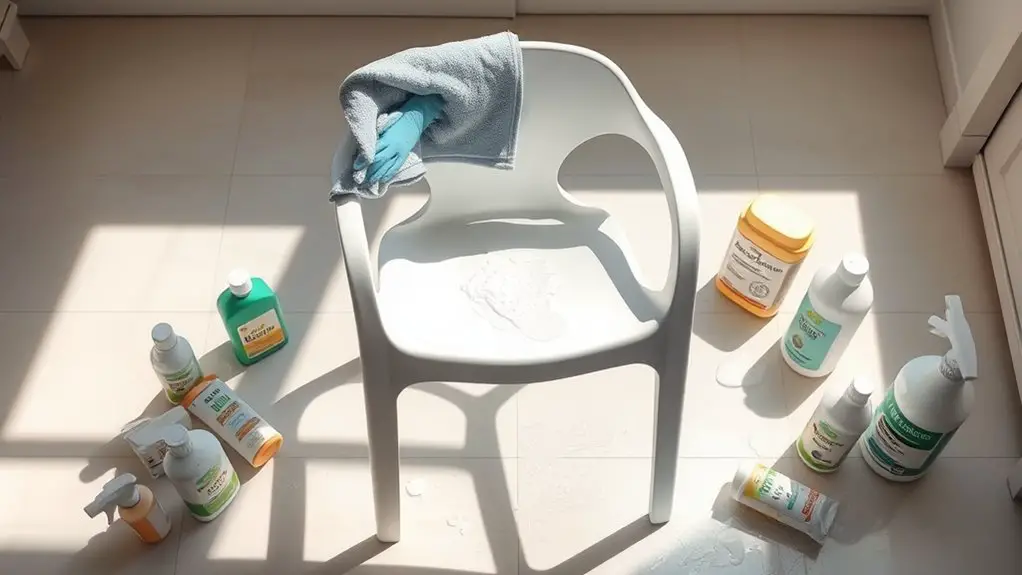To keep your plastic furniture looking its best, you need a solid care routine. Start by mixing mild dish soap with warm water for everyday cleaning. For tougher stains, use white vinegar or a bleach solution—just remember to wear gloves! Be sure to scrub gently with a soft-bristled brush to avoid scratches. Rinse thoroughly to remove any soap residue, then dry completely. Regularly inspect your furniture for signs of wear and store it protected when not in use. With these tips, you'll extend the lifespan of your plastic pieces. Stick around for more expert insights!
Key Takeaways
- Establish a regular cleaning routine using mild dish soap and warm water to prevent dust buildup and maintain appearance.
- Use a soft-bristled brush and vacuum cleaner for initial cleaning, ensuring delicate surfaces remain undamaged.
- Rinse thoroughly with clean water after applying any cleaning solution to avoid soap residue that can degrade furniture.
- Protect furniture from extreme weather by covering it or storing it indoors to prolong its lifespan and prevent fading.
- Regularly inspect for cracks and wear, addressing issues promptly with repairs to ensure longevity and functionality.
Essential Cleaning Solutions
Cleaning your plastic furniture effectively requires the right solutions to tackle stains and grime. One powerful option is bleach.
Mix 1/4 cup of bleach with a bucket of warm water, and wear protective rubber gloves to safeguard your skin. Use a scrub brush dipped in this solution to gently scrub the furniture, allowing it to sit briefly before rinsing with a garden or power hose. For optimal results, ensure the plastic furniture is made from high-density polyethylene or similar durable materials.
If you prefer a natural alternative, combine 1/4 cup of white vinegar with warm water. This solution's great for white plastic, dissolving dirt and stubborn stains. Scrub and rinse thoroughly for best results.
For a versatile cleaner, mix 1 gallon of warm water with 2 tablespoons of dishwashing soap and 1/4 cup of bleach, or stick to a gentler approach with 1 tablespoon of laundry detergent in a gallon of water. Scrub well and rinse.
Lastly, consider specialized cleaners like 303® Patio Furniture Cleaner or Mr. Clean Magic Eraser for tough stains. Regular cleaning helps prolong the lifespan of plastic furniture, making this maintenance essential for keeping it in top condition.
If you want an eco-friendly option, try Earth Scrub, made from baking soda, liquid soap, and vinegar. These solutions will keep your plastic furniture looking great!
Preparation and Tools Needed
Before you start cleaning your plastic furniture, gather the right tools and supplies to make the process smooth and effective.
You'll need a soft-bristled brush to gently scrub away dirt and debris, and a vacuum cleaner—preferably one with a dust-brush attachment—to remove loose dirt.
Have a few microfiber cloths handy for dusting and wiping down surfaces. A garden hose will be essential for rinsing off soap and debris, so keep that accessible as well.
Don't forget a bucket for mixing your cleaning solutions.
For your supplies, mild dish soap or a gentle detergent is ideal for cleaning. Regular cleaning and maintenance is essential to prevent the buildup of contaminants that can pose health risks.
White vinegar can help remove stains and mildew, while baking soda is great for creating a paste to tackle stubborn stains.
Mix these with warm water for the best results. If you choose to use liquid bleach for sanitizing, do so with caution.
Optional tools like a whisk broom can help with textured surfaces, and nylon white-backed sponges will prevent scratching.
Finally, consider wearing cleaning gloves when handling bleach or other harsh chemicals to protect your hands.
Step-by-Step Cleaning Process

Your plastic furniture deserves a thorough cleaning to keep it looking its best. Start by removing loose dirt and debris. Use a soft-bristled brush, beginning at the top and working your way down to catch every particle. For intricate carvings, employ a gentle vacuum attachment and use a whisk broom for initial cleaning. Dust off natural wicker or similar materials with a clean cloth or microfiber duster.
Next, mix a cleaning solution. Combine lukewarm water with a few drops of mild dishwashing liquid in a bucket. For stubborn stains, use a mixture of one part white distilled vinegar to one part water. You can also create a baking soda paste for gentle abrasive cleaning. Synthetic plastic is lightweight, fade-resistant, and versatile in design, making it ideal for outdoor furniture.
Apply the solution with a sponge or soft-bristle brush, scrubbing gently to avoid damage. Rinse the furniture thoroughly with clean water after scrubbing, using a hose or bucket if needed. Finally, dry your furniture completely with a towel or let it air-dry.
To restore shine, apply automotive paste wax and buff with a microfiber cloth. Regular cleaning will maintain your furniture's pristine condition for years to come.
Specialized Cleaning Tips
After completing the step-by-step cleaning process, it's time to focus on specialized cleaning tips that can tackle specific challenges.
For white plastic furniture, bleach works wonders—mix 1/4 cup with a bucket of warm water, but remember, it's not for colored plastics, as it can cause fading. Always wear protective gloves when using bleach.
If you're looking for a natural option, white vinegar is effective for both white and colored surfaces. Mix 1/4 cup with warm water and scrub away using a brush. Rinse with a garden hose for best results.
Baking soda is another great choice for stubborn spots. Sprinkle it on a damp sponge and scrub the affected area, then rinse thoroughly.
For routine cleaning, dishwashing liquid mixed with warm water is perfect. You can even combine it with bleach for tougher stains. Additionally, using a soft-bristle brush can help prevent scratching while cleaning.
And don't forget your garden hose for a thorough rinse, ensuring no soap residue remains.
Maintenance and Protection Strategies

Maintaining and protecting your plastic furniture is essential for prolonging its lifespan and keeping it looking great. Start by establishing a regular cleaning routine. Remove dust and debris using a soft brush or cloth to prevent scratches. Depending on usage, set a cleaning schedule—daily or weekly.
For general cleaning, use mild dish soap and warm water, then rinse thoroughly to eliminate soap residue. Always let your furniture air dry completely before use. Regular maintenance preserves appearance and extends the lifespan of your furniture, ultimately saving you costs.
To shield your furniture from the elements, cover it or move it indoors during extreme weather. Apply UV-resistant coatings to prevent fading and weakening from sunlight. Avoid placing hot objects directly on plastic surfaces; coasters can help protect against heat.
When not in use, store your furniture in a dry, sheltered area, and cover it during off-seasons to guard against dust and moisture.
Regularly inspect for cracks or signs of wear. If you find any damage, use epoxy glue or a plastic welder for repairs. Remember, addressing issues promptly can prevent further deterioration.
Frequently Asked Questions
How Often Should I Clean My Plastic Furniture?
You should clean your plastic furniture every 1-2 weeks to keep it looking good and prevent dirt buildup. In high-usage areas or humid climates, increase the frequency to avoid mold and mildew growth.
Can I Use a Pressure Washer for Cleaning?
Yes, you can use a pressure washer to clean plastic furniture. Just start at a safe distance, use a low setting, and test a small area first to avoid damage. Always rinse thoroughly afterward.
What Should I Avoid When Cleaning Colored Plastic Furniture?
When cleaning colored plastic furniture, avoid bleach, acetone, abrasive scrubbers, and leaving solutions on too long. Don't forget to spot test, rinse thoroughly, and use gentle cleaning tools to protect your furniture's finish.
Is It Necessary to Apply Wax After Every Cleaning?
It's not necessary to apply wax after every cleaning, but regular applications every 3 to 4 months will enhance protection and maintain shine. You'll find it easier to clean and protect your furniture this way.
How Can I Remove Odors From Plastic Furniture?
To remove odors from plastic furniture, sprinkle baking soda, scrub it in, then rinse. Alternatively, use a vinegar solution or let the furniture sit in sunlight. Regular cleaning prevents odors and keeps your furniture fresh.

